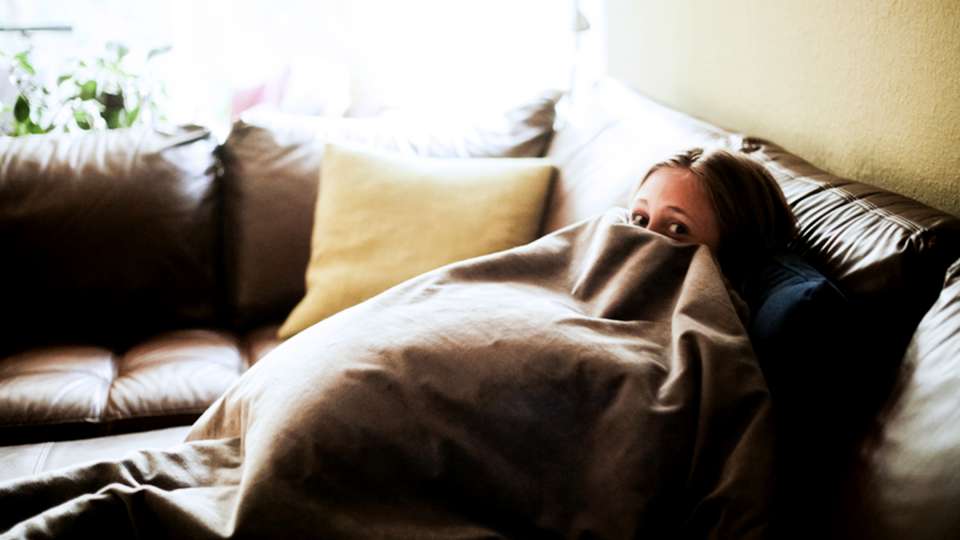
Your chest feels tight. You can’t catch your breath, and when it does come in, it’s fast and shaky. You feel flushed, feverish and your body is going into a cold sweat.
Shortness of breath, fever. You know these are COVID-19 symptoms. But they’re also symptoms of something you’ve been feeling a lot of lately: anxiety.
So, do you have the coronavirus? Or are you having a panic attack?
“There are some key differences, but there are also some symptoms that could overlap,” acknowledges Dr. Jennifer Erickson, a psychiatrist who sees patients at UW Medical Center – Montlake and the UW Neighborhood Clinics.
What’s more, many people who are at heightened risk for a severe illness from COVID-19 are also more likely to experience anxiety, such as people who have an existing chronic illness.
Here’s how to tell the difference between COVID-19 and anxiety and what to do if you’re still not sure.
What an anxiety attack can feel like
Anxiety can show up in many ways. Sometimes it’s minimal but lingering in the back of our minds for long periods at a time. Other times we get a flash of intense anxiety that goes away more quickly.
The latter experience is called a panic attack (or anxiety attack) and while they’re more common among people who have existing issues with anxiety, they can happen to anyone at any time.
Though panic attack symptoms and severity vary for everyone, these are some of the symptoms that can happen: shortness of breath, fatigue, tension throughout your body, chest pain, feeling out of control or like the world is ending, feeling claustrophobic or outside of your body, getting chills or hot flashes, nausea, sweating, having flushed or warm skin, or even having numbness, tingling or pain in your neck or back.
To someone who hasn’t experienced a panic attack or much anxiety before, many of these symptoms could seem like the shortness of breath, body aches, fever, extreme fatigue or nausea that have become hallmarks of COVID-19.
In fact, people often assume their panic attack is something more dangerous, like a heart attack, Erickson says.
“It’s quite common that with someone’s first panic attack they’ll take themselves to ER,” she says.
How COVID-19 symptoms are different from anxiety
There are a few key differences that happen during COVID-19 but not during anxiety, Erickson says.
It’s important to pay attention to these because this is how you’ll know if what you’re experiencing is anxiety or something more medically serious.
First, Erickson recommends checking your temperature. Try not to do this regularly — once a day will work. It’s pretty simple: If you don’t have a fever (usually defined as 100.4 degrees F or higher), your symptoms are probably caused by anxiety, not the coronavirus.
It’s also important to really tune into what’s going on in your mind and body. If your thoughts are racing or you feel an impending sense of doom, those are also signs that anxiety is the culprit.
Another way to test yourself is by trying a distraction technique. Pick an object in the room — like a houseplant or something that has a lot of different angles — and focus your attention on it. Notice variations in texture, shape and color. Trace the lines of the object with your eyes.
“If you notice you’re starting to calm down and your shortness of breath is getting better, then it’s probably anxiety related,” Erickson says.
One final way you can tell the two apart is by how quickly your symptoms show up. Did they develop gradually over time, and did things like a cough appear first? Or did your symptoms come on suddenly?
“An anxiety attack will come out of the blue and you won’t be feeling ill before that; you may feel tense or stressed but you won’t have muscle aches or a runny nose or a cough,” she explains.
What to do now
So you’ve checked your temperature and you have a fever. Or you don’t have a fever but you have other symptoms, like a cough. You’re still not certain if you have anxiety or something else.
At this point, it would be a good idea to contact your doctor and see what advice they offer. If you do have something besides a panic attack going on, you don’t want to delay getting help. And even if you’re pretty certain it’s anxiety but still aren’t 100% sure, getting reassurance from a medical expert could be helpful.
If, however, you’re convinced that you’re dealing with a panic attack, here are a few things you can do to reign your anxiety in.
Remind yourself this will pass
When you’re actively panicking, it can feel like it will go on forever. But it won’t.
“In the middle of a panic attack, one thing to remind yourself of in that moment is that, yes it’s uncomfortable, but it will pass,” Erickson says.
Distract yourself
Erickson recommends finding ways to distract yourself out of panic. This could mean looking closely at an object and studying its lines and colors, or it could be holding ice cubes in your hands and focusing on the sudden temperature change.
If you focus hard enough on the distraction, it will help pull your mind out of its anxiety spiral.
Try square breathing
Square breathing, sometimes called box breathing, is a breathing technique that aims to steady your intake and outtake of breath. Anxiety often makes us hyperventilate, which then contributes to more anxiety, creating a vicious cycle.
To try square breathing, breathe in for four seconds, hold your breath for four seconds, breathe out for four seconds, then hold again for four. Keep repeating this pattern until you notice you’re feeling less tense.
Schedule worry time
If you’re feeling overwhelmed by anxious thoughts, it’s worth scheduling yourself some worry time.
Trying to avoid or deny worry isn’t going to make it go away; in fact, that often makes it worse. So set aside some time each day as designated “worry time” where you’ll allow your mind to go down as many panicked rabbit holes as it wants.
Set a timer for ten minutes or whatever feels right to you, worry for that amount of time, and then when the timer goes off get back to your day.
Start a worry journal
If worry time isn’t doing it for you, try starting a worry journal where you write down all your fears and concerns. You can set a designated time to do this, such as before bed or when you wake up.
Try not to write in it constantly throughout the day. The point is to get your worries out of your system then close the journal and move on to other tasks.
Try relaxation techniques
There are a bunch of relaxation techniques therapists teach their clients for easing muscle tension and other physical symptoms of anxiety in a short amount of time. These include things like progressive muscle relaxation or deep breathing.
Give one or several of them a try and see if they help. Sometimes relieving your physical anxiety symptoms will also help your anxious thoughts go away.
Give yourself credit
Sometimes, feeling anxious or having panic attacks can make someone ashamed or embarrassed or feel like they don’t have their life under control. Those feelings are understandable, but do your best to banish them.
Focus on the fact that you recognize the problem and are working on getting help. Don’t try to be perfect; just focus on the fact that you’re making progress.
“Everyone is doing as well as they can right now. We should all take credit for that,” Erickson says.
The info in this article is accurate as of the publishing date. While Right as Rain strives to keep our stories as current as possible, the COVID-19 pandemic continues to evolve. It’s possible some things have changed since publication. We encourage you to stay informed by checking out your local health department resources, like Public Health Seattle King County or Washington State Department of Health.

 Healthy ideas for your inbox
Healthy ideas for your inbox





